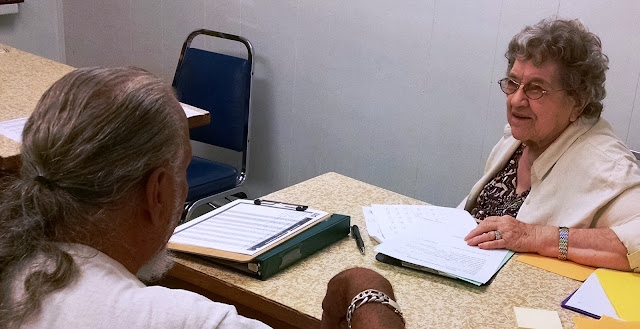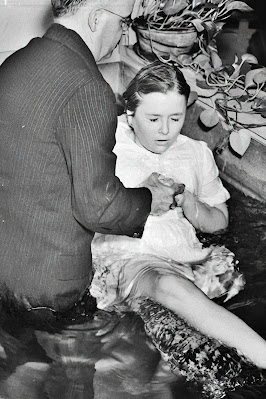 | |||||
| Rose Flynn helps a person seeking groceries. |
Community ministry is part of Baptist Temple’s DNA. The church’s involvement dates to the Great Depression when food, clothes and medications were brought to the homeless camp near the church. Even before then, the Women’s Missionary Union (WMU) had always been active in local ministry actions. Furthermore, Community ministry ran parallel to the recreation ministries of the Church Recreation Era. The medical clinical and methadone program stand out prominently during these years.
As church attendance declined and the community changed,
staff reductions became necessary. Ministries that
focused on recreation and life stages were reduced to part time or combined
with core staff positions such as Associate Pastor or Minister of Music.
What marks the Community Ministry Era as distinct, is the way it dominated the conversation and the budget of Baptist Temple from 1995 to 2020. Beginning with the pastorate of Mark Newton, in 1995, there was a marked decline in the interest of sports. Subsequently, the ballpark and Pipe Creek properties went up for sale. Although, Young in Heart was still active, the numbers were down and most of the seniors that were “coming of age” were more interested in serving opportunities than in sightseeing.
There had always been a struggle between those who looked at the church to provide member services and those who wanted to reach out to the community. Early victories by the “member services group” were gained with the closure of the TOUCH methadone clinic (1974-1984) and Fighting Back (1991-98) but the community ministry voices were growing stronger.
In 1998, Newton launched the Going Beyond These
Walls
campaign; an effort to encourage church members to engage with ministry in the
community. Among the highlighted ministries at the time were the Christian
Women’s Job Corps, Community Homeless Street Ministry, Habitat for Humanity, and
the Prison Ministry. One lasting result was that two Habitat for Humanity homes
were built in 2000 and 2001.
Community Ministry received another boost in 2006, when ten percent of the money received from the Pipe Creek property sale was set aside for missions. Suddenly, the Community Ministry Committee seemed to be continually at work with projects that included Highland Park Elementary School, Southeast food pantry, Grace House, Fall Festival, the Christian Women’s Job Corps, and more. People would rally whenever a community ministry event was announced.
However, most of these
efforts took place off campus. Our centrally located, 80,000 square foot campus
on nearly three acres, was eerily quiet during the week. I wondered, “If the church
buildings were to disappear overnight, who would miss them?”
I also wondered, “How
can we make this campus an asset to the community? A lighthouse shining God’s
light to our neighbors?”
We were able to make
some easy changes right away. We had a three-story education building that lay
dormant all week. Jubilee Academy quickly filled it with a charter school.
Soon, our daycare was accepting vouchers so that children from our neighborhood
could attend one of the best daycares in the Southside. Plus, we added after
school care. The gym was another underutilized asset but now, the school uses
it during the day and a growing number of community recreation groups use it at
night.
Taking advantage of a
grant offered by the Baptist General Convention of Texas, we hired Wesley Craig
to be Baptist Temple’s first Minister of Missions in 2009. His job was to
organize the many great ideas that were floating around, channel the tremendous
energy generated by the zeal for community ministries, and liaison with the
many local, state and national organizations with whom we could partner.
Craig arranged for the
San Antonio Food Bank mobile food pantry to come to Baptist Temple once a month
and provide shopping cart loads of groceries to over 200 people. We also became
among the first San Antonio churches to become a Summer Feeding site for the
Food Bank. Summer ministry interns and mission teams would provide a free
summer day camp that was organized around the free lunch.
The building at 850 E.
Drexel had been unused since 1998. It had been considered for ministry use from
time to time, but the cost seemed too high. In 2011, God laid it on the hearts
of Baptist Temple’s members to remodel the property for ministry use. Money,
labor and material were donated by young and old, and the Max Brunnemann
Building was dedicated that Fall. It would house the thrift store, food pantry
and community garden.
Sharing space was another way for Baptist Temple
to serve the community. Sixteen churches have worshiped on the Baptist Temple
Campus over the past decade. Along with churches a variety of organizations
have delivered needed services as well. From school supplies, to parenting
classes, to funerals, the Baptist Temple Campus has become a support hub, providing
for the physical and spiritual needs of our under-resourced community.
When the need to replace the playground arose,
we decided to make it inclusive. That way children with disabilities would be
able to play with children of typical abilities, helping them to overcome the isolation
that can be more painful than the physical limitations. We were able to create
a playground worth a quarter million dollars with the help of our partners and
friends.
Partners and friends helped us to purchase and
remodel a house adjacent to the church. Short-term mission volunteers stay at
the house and serve the community in a variety of ways, usually working with
children.
We are currently in the process of overhauling
the gym. It remains an important resource to our community, teaching youth to
develop a lifestyle that embraces healthy habits and helping adults fight
obesity and its related diseases. Once again, our partners and friends have
helped us to be a blessing to our neighbors.
Prior to the disruption of the pandemic, we had over 1000 folks on the campus each day. If the buildings were to disappear overnight, they would be missed by many. By God’s grace Baptist Temple entered the 21st Century as a beacon to this community. Jesus said, “Let your light shine before others, that they may see your good deeds and glorify your Father in heaven.” Matthew 5:16


